| Construction Rating: | starstarstarstarstar_border |
| Flight Rating: | starstarstarstarstar_border |
| Overall Rating: | starstarstarstarstar_border |
| Diameter: | 1.64 inches |
| Length: | 28.00 inches |
| Manufacturer: | Estes  |
| Skill Level: | 4 |

Brief:
This rocket is an 18mm single stage NASA-esque satellite booster that has a clear payload bay with satellite and
parachute recovery, It is OOP.
I found this kit on eBay and probably payed way too much for what I got, but I liked the looks of it.
Estes rates it as a skill level 4 so that will make it, by reputation anyway, the most complicated rocket I have done yet.
Construction:
Construction starts with putting together the motor mount. This was done in close to typical Estes fashion but I made
a few changes. The first step was to mark out the motor tube and then slice a slit for the retaining hook. That's
simple enough and is fairly common. The builder is then instructed to put 2 wraps of masking tape around the mount to
secure the hook, 1 inch from the aft end. That too is standard.
When it came to installing the centering rings though, I made my first change. The kit is provided with the standard Estes tri-fold and worthless piece of rubber. I don't trust these so I cut a 48" piece of Kevlar®. I cut a notch into the forward centering ring and then mounted the rings as directed with the Kevlar® passed through the forward ring. The Kevlar® was then tied around the tube. The rings were then glued into place and filleted.
The second modification almost did not happen. It seemed that something was missing and then I realized I had not yet put in the thrust ring. Upon looking in the bag and then examining the instructions, I was horrified to learn that this model does not include one. I have made the mistake of forgetting to install them in the past and that has led to much wear and tear as the motor hook tears at the motor tube. I happened to have the right size one from Semroc on hand and installed it.
While the motor mount was setting up, I examined the balsa. This kit apparently comes from die cutting day and the balsa was not laser cut. It was also broken in a few places. Fortunately, none of the breaks went through an actual component. It was sometimes difficult to see exactly what the proper boundaries of a given piece was but they were all identified and cut out. I then rounded the leading, trailing and outer edges of the 4 fins. Also in the balsa sheet were a pair of stand offs for the launch lugs and a long pair of standoffs for the booster pods. I did not sand a profile in there. All balsa was filled with Elmer's Wood Filler.
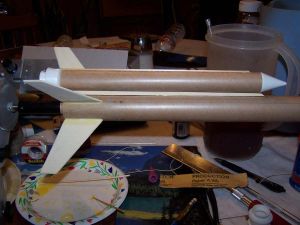
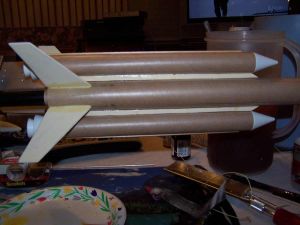
The final act of this evening's festivities was to thread the Kevlar® through the main body tube and install the motor mount. A long swab was used to run a ring around the interior on the large BT. The mount was then inserted part way and another ring of glue was put in. The mount was then shoved the rest of the way in to a point where the motor tube just peeks out the back.
After sanding the balsa down and getting it reasonably smooth, it was time to start doing some real assembly. Since there is a lot going on around the bottom of this rocket and there is not much room, I decided to employ my Art Rose fin jig. This was in addition to using the wraparound fin guides provided by the kit. I marked the tubes according to the guides and then extended the lines on a door frame. For some reason, that always works better than the Estes fin guide I bought. After that, I selected the 18mm mandrel and put the main BT on the jig.
To attach the fins, I used CA but first perforated the root edges and the BT along the contact line in order to form glue rivets. This is a technique I learned about not too long ago and about which I have become a devoted fan. It really does seem to strengthen the joint.
While waiting for the fins to set up properly, I worked on the strap on boosters. There are two of them and each requires a balsa standoff on the side towards the main rocket and a piece of dowel glued on the opposite side. The stand off is supposed to be exactly the length of the strap on and was. The dowel is supposed to be 9" long and have its upper end cut at a 45 degree angle. This was accomplished with an X-Acto knife.
I glued the standoff to the booster tubes using the same rivet method and CA that I used to attach the fins. I found a slight bow in both of the standoffs and used tape to hold them down while the glue set. Note that the standoffs have their upper ends cut with a bevel. The shorter side goes towards the booster. That is the only way they will fit.
When I judged the standoffs dry enough, I applied the dowel. In this case, I did not bother with riveting and just used yellow glue.
While the boosters were setting up, I worked on the launch lugs. These too require standoffs to clear the payload bay. Two standoffs are provided in the kit and my kit had two launch lugs as well. That is one extra because the instruction say to cut a lug in half and, sure enough, half of one provided lug is a fit for the top of the stand off.
I glued the standoffs to the launch lugs with yellow glue and let that set up. I then again perforated the base of the standoffs and the BT to form rivets. I glued on the lower lug flush with the bottom of the BT with CA and let that set up for a few minutes. I then placed the other lug on a short section of 1/8" rod, inserted the rod into the lower lug and glued the upper on in place using the rod for alignment.
Installing the boosters was next. I knew one booster would go on fine but expected a problem with the other one. The tube was a bit out of round on one end. I decided to go ahead and cut out the booster nose cone and nozzle at this point to use as a mandrel to keep the tube straight.
The NC and nozzle are cast in a single piece of styrene and must be separated. To do this, I used an X-Acto saw. I dutifully started cutting through the groove and found the process to be more difficult than I had imagined. The problem was keeping things straight. Eventually, though, I got through. I then sanded the rough edges and slipped the pieces into the deformed booster BT. [Note: I did not glue them at this point.] That rounded it out nicely.
To attach the boosters, I again perforated the balsa and the BT and glued with CA. While doing this, I left the assembly on the fin jig to keep everything nice and level. I pressed the booster on, held it down for a little bit, and then rotated everything 180 degrees and did the same with the other side.
Once the boosters were in place, I gave all of the joints a fillet of yellow glue on one side and proceeded to work on some more plastic.
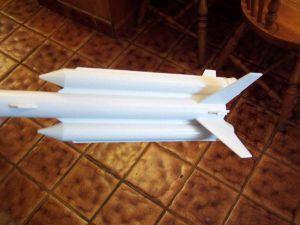
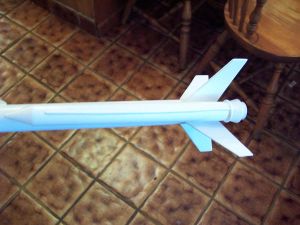
The transition, payload, and main nose cone are all cased as a single unit. Again they needed to be cut apart and some parts were discarded. I again used the X-Acto saw but had an easier time of it because I changed my method. Instead of starting on one side and sawing down until I got to the other, I drew the saw across the joint, applying very little pressure. I then rotated the assembly a bit and did the same thing. After going around the circumference in this manner three time I had complete separation. I found doing it this way made it much easier to get a straight cut. [Note: the NC is separated from the rest of the assembly but the payload is not separated from the transition. It is a piece between the NC and payload which is discarded.]
Now that the pieces were separated, I sanded them down and used the razor knife to remove large pieces of flash. Another sanding and I could proceed with the first step of painting these parts.
I gave the plastic two coats of Krylon gloss white and allowed them to dry. It did not take too long for the pieces to dry to the touch but it was still much too soon to start masking. Upon close examination of the instructions, I realized that I could go ahead and paint the interior of the NC flat black and not have to do any masking. I brushed on the black and let it dry. I was not worried by the few specks that wound up on the edge because these will be hidden in the final assembly.
After the white had a chance to dry on the payload section, I started to give it its paint scheme. While some people may me able to mask something like this, it is mostly beyond my meager abilities. I decided to use a brush and be very careful.
Gold was the first to go on. I did not bother masking for this because everywhere that the gold touched, something else would be put on top.

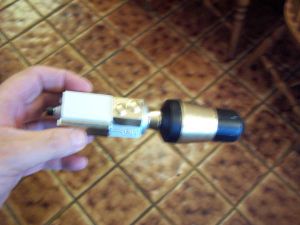
Then I made another blunder. I thought the gold paint was dry. I masked it off on the transition and where the transition is connected to the payload so that I could paint on the black. For the first time, my masking worked very well and there were no noticeable leaks. To make up for this, the tape pretty much ruined the appearance of the gold. I got out a fine brush and retouched the gold areas. I also started painting the silver areas.
I did not do this exactly according to the instructions because I could see no way to mask the appropriate areas nor could I depend on my hands to be steady enough to do the job.
While I had the gold paint out, I also masked 3/8" from each end of the clear plastic tube of the payload bay. I painted the lower end gold and then got out the silver and took care of the upper end. The purpose behind this step is to help hide the transition from the plastic transition and nose cone to the clear plastic payload bay.
Now, the painted plastic was setting up and It was time to revisit the main body. I was very pleased with gloss white appearance. I was pretty sure it was dry so I masked all but the top 2" of the central body tube. This was sprayed gold.
Being my impatient self, I decided to try and paint the raised areas on the payload bay at this point. The silver of the whole area was in place but there were a few areas raised in the plastic I thought would stand out better in gold. Accordingly, I used a brush laid on its side and tried to roll it gently over just the raised areas. It worked pretty well.
Also before assembly can continue, a few decals need to be put in place on the payload.
I have noticed two types of waterslide decals in the past. One type is a continuous sheet and you cut out the portion you want to use. The other type has the decals on the same sheet but the actual decal material does not extend much beyond the printed part. In effect, each decal has its own clear border. The decals of this model were of this latter type.
The instruction say, however, that the decal should be trimmed right up to the printed line. I did this with a pair of scissors. I don't know if this was caused by age, but these decals needed a lot more soaking than normal. The decals for the solar panels were put in place and I saw that were was no margin at all for the clear edges. They fit perfectly.
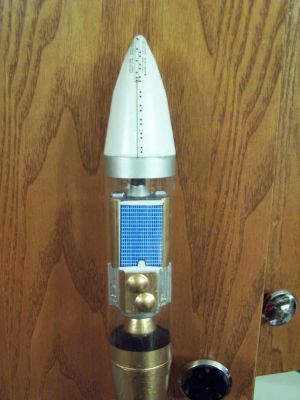 Now, it was back to real construction again. I was going to start assembling the stack. I had already
installed a lengthy piece of Kevlar®
to the motor mount but did not want to insult the Kevlar®
industry by tying it off to the measly little piece of brittle rubber band that Estes provided. I substituted a 3 foot
length of 1/4" sewing elastic. I like watching a long parachute train. The shock cord was then tied off to the
plastic transition and stuffed into the central body tube.
Now, it was back to real construction again. I was going to start assembling the stack. I had already
installed a lengthy piece of Kevlar®
to the motor mount but did not want to insult the Kevlar®
industry by tying it off to the measly little piece of brittle rubber band that Estes provided. I substituted a 3 foot
length of 1/4" sewing elastic. I like watching a long parachute train. The shock cord was then tied off to the
plastic transition and stuffed into the central body tube.
The next item up in the stack was the clear plastic tube of the payload bay. I had already painted a gold stripe on the lower end and a silver stripe on the upper. All I had to do was slip it in place and glue it.
This is where my next big blunder came into play.
I decided to use thin CA since it dries fast and I did not want it to either run or protrude from the seam. That was a bad choice. It did dry fast but it also ran out the seam and dribbled down my gold paint. After the CA really was dry, I touched it up again with brushed on gold.
I then spent some time reexamining the instructions and found my next blunder. I had omitted two small decals from the payload compartment, which was now inaccessible. These decals were red lettering meant to serve as warnings for those who handle the satellite. They are extremely small and I don't think they will be missed too badly. Besides, even when I sailed tall ships, I never learned the skill of building a ship in a bottle.
All that was left was to place the nose cone at the top of the plastic tube and let it dry. This time I used thick CA and had no problems with running.
PROs:different looking
CONs: tri-fold shock cord mount and short rubber band, no thrust ring
Finishing:
A good deal of the finishing took place during the construction of this rocket. This included sanding and sealing but
also included painting the body tubes, nose cones, and payload, as well as placing the payload decals. Up until this
point I had been extremely pleased with both the rocket and myself. The application of the decals is where that fell
apart.
There are a good number of decals. They are well thought out and greatly enhance the looks of the rocket. There were, however problems. I do not know if the problems were because of the age of the decals or their thinness. I suspect it is a little of both.
I mentioned in the section of the payload decals that they took an extremely long time to release from the backing paper. I found this to be generally true of all the decals. I found a big difference as well.
The solar panels for the payload were easy to slip around and get into place. The rest of the decals were not so easy. Generally, once they had gripped, there was very little move to them.
This led to me noticing a second problem. They are extremely brittle and tore easily. Some of the torn decals I was able to work back into place so that they are not noticeable. Most, however, gripped too quickly. The result is a plethora of decals whose alignment is sub par.
If I were to do this again, I would scan the decals to fresh decal paper and try it with my own decals.
I like this rocket. It looks cool. Unfortunately, mine will not bear close scrutiny.
Construction Rating: 4 out of 5
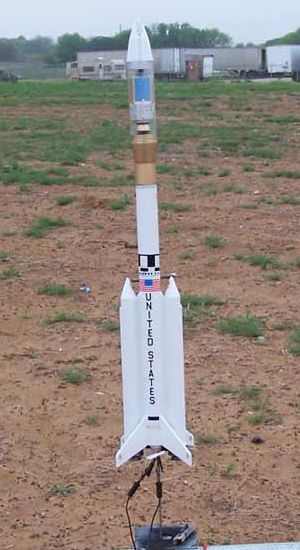
Flight:
Recommended Motors: B4-2, B6-2, C5-3, C6-3.
I chose a B4-2 for the first flight. It was a windy day and I do not want to lose this rocket. Earlier in the day, a B had done a good job on another rocket that seemed to weigh about the same. I did not account for the drag on this one.
The rocket boosted off the pad and looked really good right until it began falling to earth. The problem was it was falling very soon after not going very high and with no sign of the chute. Not long before it would hit the ground, the ejection charge finally went off. The chute came out but did not have time to open. It landed flat on the ground and broke off two fins. This will be an easy repair and the rocket will fly again.
The B motors are recommended. I'm not sure if I got a bad one, if my rocket is just too heavy, or if it is a bad recommendation. I will fly it next on a C and reserve judgment until then.
PROs: looks good on the pad, looks good in flight
CONs: looks lousy as it crashes
Recovery:
Recovery? You mean the chute was supposed to come out?
Flight Rating: 4 out of 5
Summary:
I still like this rocket. It was not too hard to build though I would recommend some building experience before
tackling it. Based on its short flight, it does fly well too.
I hope to have many such good flights in the future.
Overall Rating: 4 out of 5
 |
 |
Flights
Sponsored Ads
 |
 |











